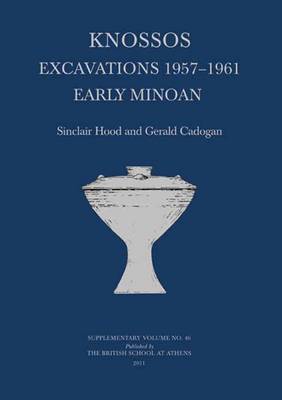BSA Supplementary Volume
2 primary works
Book 46
From 1957 to 1961 the British School at Athens undertook an extensive programme of stratigraphical excavations at Knossos under Sinclair Hood, then Director of the School. This report publishes in detail the results of investigations into Early Minoan levels, which shed much new light on the era before the "Old Palace" was established. The three excavations comprised: an Early Minoan I deep well, the oldest at Knossos; trials on the north side of the Royal Road, with Early Minoan II-III house remains; and similar trials in the Early Houses below the South Front of the Palace, which included investigation of the South Front House of Early Minoan III.
The volume provides invaluable data on the types and phased development of pottery in this major settlement site of the third millennium BC, a period when much of our Cretan evidence derives from tombs. It also helps to chronicle the expansion of Knossos during the Early Bronze Age and offers new insights into the material culture of Prepalatial society, including possible feasting in Early Minoan I, new evidence for olives and wine and well-dated Early Minoan III seal impressions of the Parading Lions group. A valuable addition is a chapter devoted to other Early Minoan pottery from Knossos held in museums in Europe and the USA. Copiously illustrated with line drawings and photographs, the volume will serve as a major resource for all interested in early cultural developments in the Aegean and Eastern Mediterranean.
The volume provides invaluable data on the types and phased development of pottery in this major settlement site of the third millennium BC, a period when much of our Cretan evidence derives from tombs. It also helps to chronicle the expansion of Knossos during the Early Bronze Age and offers new insights into the material culture of Prepalatial society, including possible feasting in Early Minoan I, new evidence for olives and wine and well-dated Early Minoan III seal impressions of the Parading Lions group. A valuable addition is a chapter devoted to other Early Minoan pottery from Knossos held in museums in Europe and the USA. Copiously illustrated with line drawings and photographs, the volume will serve as a major resource for all interested in early cultural developments in the Aegean and Eastern Mediterranean.
Book 49
The signs known as ‘masons’ marks’ were carved on blocks of stone in Bronze Age Crete over a period of some 500 years from around 2000 BC until the middle of the 15th century bc. The earliest examples seem to occur at Knossos, dating from the time when the so-called Early Palace was constructed there. Soon thereafter blocks with comparable signs were incorporated in the palatial centres at Phaistos and Malia. In due course, the practice spread elsewhere in Crete and to Akrotiri on the island of Thera, but is only rarely attested on the Greek mainland. By far the greatest number of these signs occurs at Knossos, making this site of unique importance for their study and interpretation.
Volume I presents a typology and chronology of the signs, considers their distribution beyond Knossos, examines comparanda in other media and in cultures beyond Crete, and provides a detailed discussion of their purpose. It also offers a full catalogue of some 1600 signs in the Palace of Knossos and surrounding buildings. The commentary provides invaluable evidence for the architectural history of the Palace, drawing on copious unpublished observations made by Evans during the excavations and the work of later scholars.
Volume II presents a complete photographic record of the Knossian signs, numerous line drawings, as well as plans and elevations showing their location. Much of the field work for this volume was undertaken from 1978-81, following the realization that many signs were disappearing rapidly, owing to weathering and flaking away of surfaces on which they had been cut. In the years since, further losses have occurred. Thus this monumental study provides crucial documentation, never to be repeated, for the major palatial site of Minoan Knossos and will serve as a key research tool for students and scholars of Bronze Age Crete.
Volume I presents a typology and chronology of the signs, considers their distribution beyond Knossos, examines comparanda in other media and in cultures beyond Crete, and provides a detailed discussion of their purpose. It also offers a full catalogue of some 1600 signs in the Palace of Knossos and surrounding buildings. The commentary provides invaluable evidence for the architectural history of the Palace, drawing on copious unpublished observations made by Evans during the excavations and the work of later scholars.
Volume II presents a complete photographic record of the Knossian signs, numerous line drawings, as well as plans and elevations showing their location. Much of the field work for this volume was undertaken from 1978-81, following the realization that many signs were disappearing rapidly, owing to weathering and flaking away of surfaces on which they had been cut. In the years since, further losses have occurred. Thus this monumental study provides crucial documentation, never to be repeated, for the major palatial site of Minoan Knossos and will serve as a key research tool for students and scholars of Bronze Age Crete.

